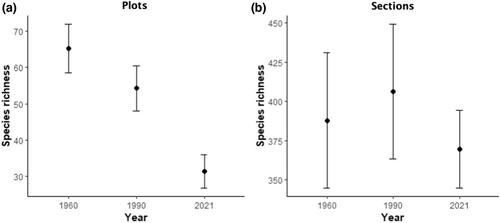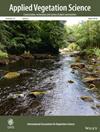Magnitude and drivers of plant diversity loss differ between spatial scales in Scania, Sweden 1957–2021
Abstract
Questions
Changed land use, nitrogen deposition, climate change, and the spread of non-native species have repeatedly been reported as the main drivers of recent floristic changes in northern Europe. However, the relevance of the geographical scale at which floristic changes are observed is less well understood and it has only rarely been possible to quantify biodiversity loss. Therefore, we assessed changes in species richness, species composition and mean ecological indicator values (EIVs) at three nested geographic scales during two different time periods, each ca 30 years, since the mid-1900s.
Location
Two parishes in central Scania, southernmost Sweden.
Methods
We analyzed species presence/absence data from three inventories at ca 30-year intervals over 1957–2021 and three geographic scales (157 m2, ca 7 km2 and ca 45 km2) to document temporal trends and differences between geographic scales in terms of species richness, species composition and mean EIVs.
Results
We found shifts in species composition across all geographical scales. However, the magnitude of biodiversity loss and the main drivers of these changes were scale-dependent. At the smallest spatial scale, we saw a dramatic loss of plant biodiversity with local species richness in 2021 being only 48% of that of 1960. In contrast, at the larger geographic scales no significant changes in species richness were observed because species losses were compensated for by gains of predominantly non-native species, which made up at least 78% of the new species richness. At the smallest spatial scale, changed land use (ceased grazing/mowing and intensified forestry) appeared as the main driver, while an increasing proportion of non-native species, as well as climatic changes and increasing nitrogen loads appeared relatively more important at larger geographic scales.
Conclusion
Our results highlight the precarious situation for biodiversity in the region and at the same time the fundamental importance of geographic scale in studies of biodiversity change. Both the magnitude and drivers of changes may differ depending on the geographic scale and must be considered also when previously published studies are interpreted.


 求助内容:
求助内容: 应助结果提醒方式:
应助结果提醒方式:


